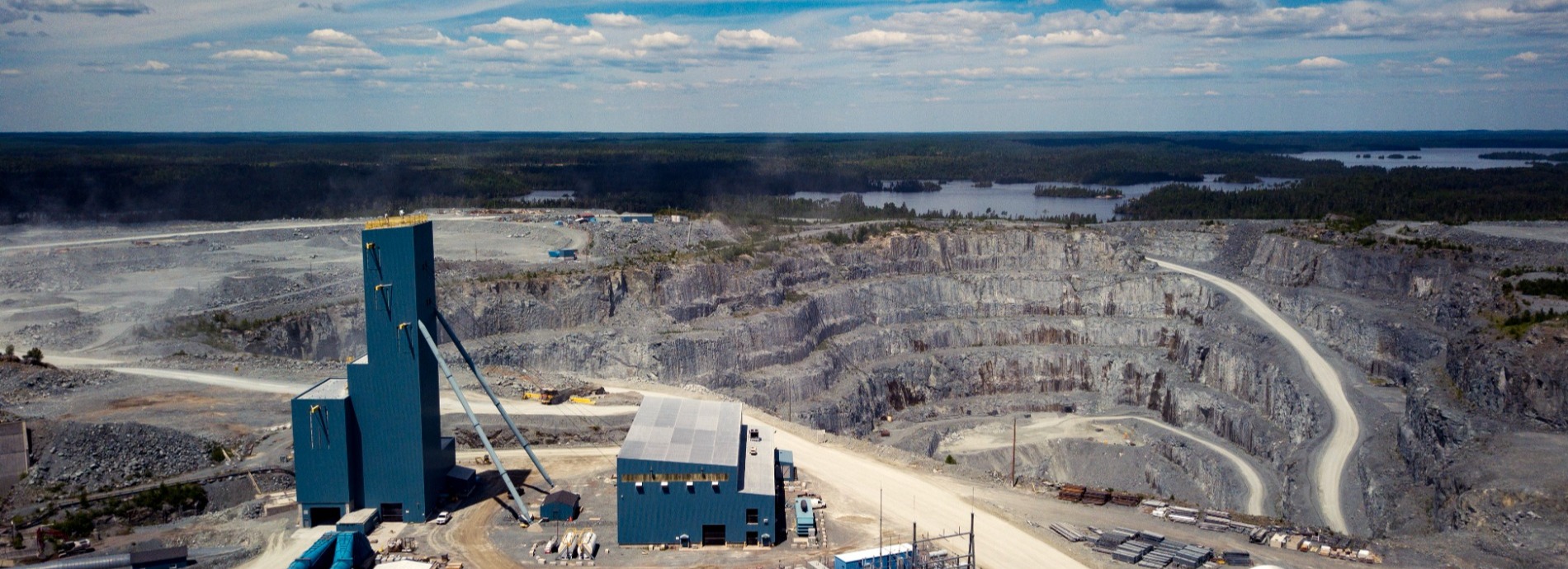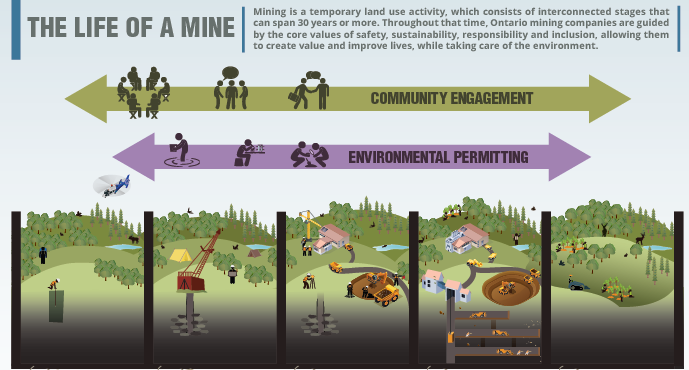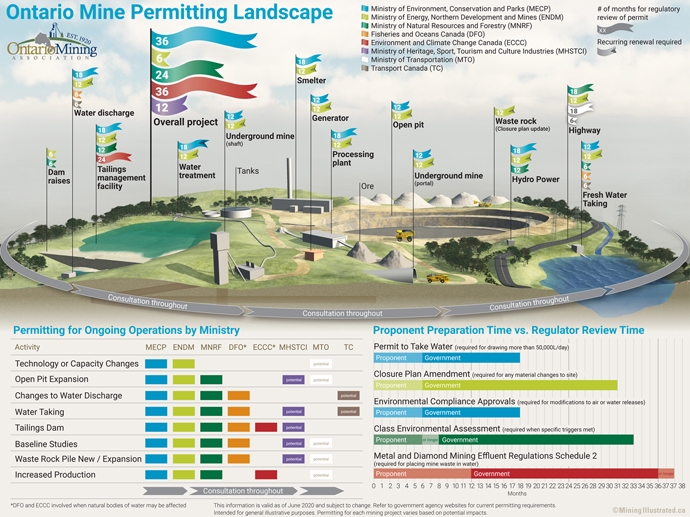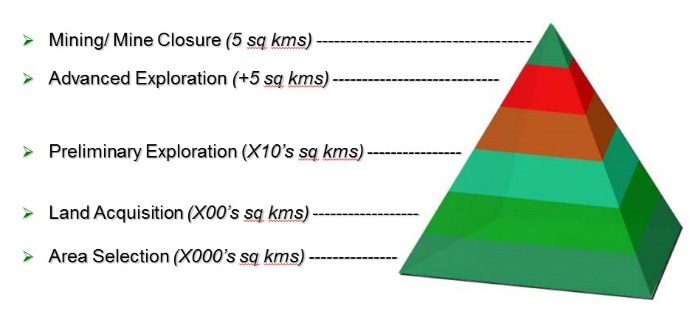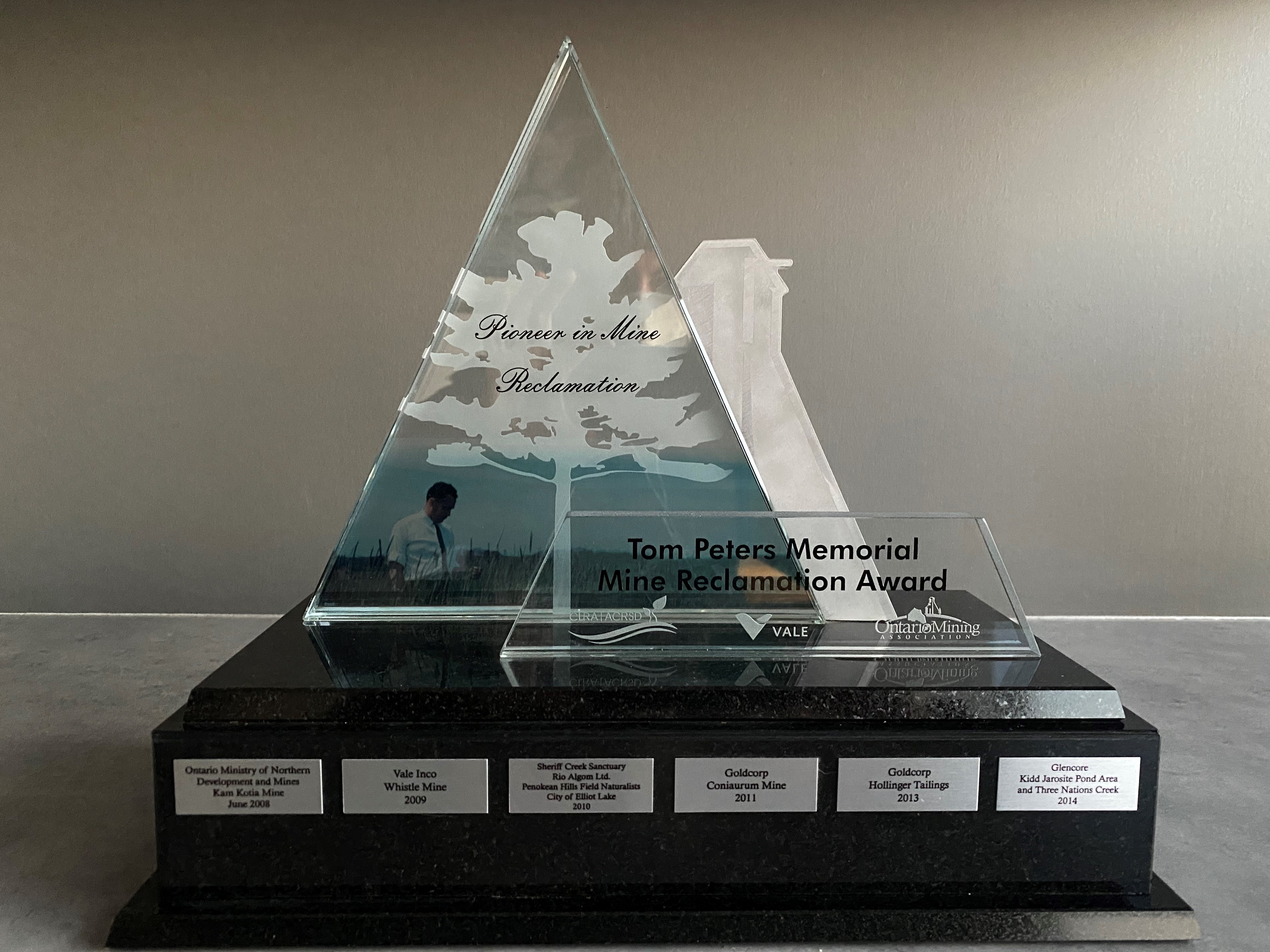Mining 101
Although the addition of even one mine can bring substantial benefits to society, the wins do not come quickly or easily. It takes a great deal of will, effort and time to discover a viable ore deposit and bring it into production.
There is no way of predicting where profitable ore deposits will be found. Each prospector and investor may fervently hope for the next "big find", but only 1 in 10 mineral exploration projects are taken to the drill stage, and 1 in 1000 drill programs unearth viable mineral deposits; ultimately, less than 1 in 10,000 projects become mines. It typically takes ten to fifteen years of consultation, exploration, data analysis, planning and financing to bring a mine into production.
Accordingly, mining leaves a very small footprint. All past and present mining operations in Ontario collectively occupy 500 square kilometres - only about 0.05% of Ontario's total land mass. Moreover, every stage of the mining process is governed by comprehensive regulations including: the Ontario Mining Act, the Environmental Assessment Act, the Environmental Protection Act, the Ontario Water Resources Act, the Public Lands Act and the Occupational Health and Safety Act, as well as a number of federal acts. In total, there are twelve provincial and federal ministries involved in regulating mining and exploration activities.
This stringent regulatory environment, combined with the industry's commitment to responsible practices and proactive approach to using new technologies, ensures that protection of public health, public safety, Indigenous cultural values and the natural environment is prioritized.
People need the products of mining and Ontario, with its world class record in both safety and environmental protection, is an ideal place to mine. In order to ensure Ontario's natural resource potential is effectively harnessed for job and sustainable wealth creation, it is essential to keep the mining cycle robust: further exploration enables exciting new discoveries; introducing new regulatory efficiencies speeds up the process of turning these discoveries into mines; new mines drive development throughout the production chain, transforming and improving productivity and wages in service industries, and bolstering highly innovative creative industries throughout the province, thus enabling a self-reinforcing upward cycle of innovation and smart, equitable growth.
Natural Resources Canada infographic.
Mining 101 - the Ontario mining process from exploration to reclamation
| Exploration |
| The mining process starts with prospecting and claim staking. Prospectors hike through the bush to collect rock and soil samples, combing the land for signs of an ore body. As part of the process to update the provincial Mining Act, Ontario launched a new online, self-service claim staking system in 2018. Anyone with a prospector’s licence can now register a claim using the electronic Mining Lands Administration System. Because it is impossible to predict where a viable ore deposit will be found, prospectors require access to as large an area of land as possible. Ultimately, only a small number of claims (0.1 percent) will show enough promise for diamond drilling and evaluation. See The Mineral Exploration Roadmap infographic. Land Access Requirements
If there are favourable signs of above normal mineral levels, basic and intermediate exploration will begin upon submitting an exploration plan to the Minister of Northern Development, Mines, Natural Resources and Forestry or obtaining an exploration permit. Consultation with affected Indigenous communities is required before any exploration activities are conducted. Exploration activities include geological mapping and aerial surveys to obtain detailed geological data. Geophysical and geochemical tests on the ground detect the possible presence of valuable minerals through measurements of electrical conductivity, magnetic fields, or sampling of rock, soil or water. Prospectors may explore rock formations by extracting core samples with a diamond drill, stripping (removing soil and vegetation) or trenching (removing rock using jack hammers and explosives). Note that stripping and trenching usually covers only a few metres of ground. The Prospectors and Developers Association of Canada has developed e3 Plus: A Framework for Responsible Exploration, while the CIM's Mineral Resources & Mineral Reserves Committee (MRMR) publishes Mineral Exploration Best Practice Guidelines. These guidelines, along with those issued by the province, represent the working standards for the industry. Ontario's mineral reserves, particularly in base metals, are being depleted faster than they are being replenished. As such, exploration is critical both for the development of additional reserves near existing mining operations and the discovery of new ore bodies. Learn more at the Ontario Ministry of Northern Development, Mines, Natural Resources and Forestry and the Ontario Prospector's Association. Read the Exploration and Mining Guide for Aboriginal Communities. |
| Evaluation |
|
Evaluation involves advanced exploration and the start of bulk sampling and drilling in the ore body. Field camps increase in size and heavy equipment is brought in. At this stage, prospectors and mine planners gather all available data to predict the profitability of a mine and the best methods of extracting the ore. Once mapping and mineral resource data is collected, and the results are strong, the project can move forward with financing, design and planning. This typically consists of studies to help companies determine if and how a project can be safe, environmentally sound, economically viable and socially responsible. Environmental studies and permits, as well as Indigenous and public consultation, are required for all advanced exploration projects. All permit applications are posted on Ontario's Environmental Registry. This electronic bulletin board details proposals, decisions and court cases that have a potential impact on the environment. The public has the opportunity to submit comments directly online. Every advanced exploration and mining project is detailed in a closure plan filed with the Ministry of Northern Development, Mines, Natural Resources and Forestry. Companies and individuals must report how their activities comply with provincial standards protecting the public and environment, and they must guarantee that funds are available to return lands to a natural state upon completion of exploration and mining activities. Provincial mining inspectors ensure compliance with the closure plan through audits and site inspections throughout the life of the mine. Learn more from the Exploration and Mining Guide for Aboriginal Communities. |
| Construction |
|
The construction process occurs after research, permitting and approvals are completed, and a closure plan is filed. Construction of mining sites involves building the mine infrastructure (portal, shaft or open pit), roads, processing facilities, environmental management systems, employee housing and other facilities. Provincial mining inspectors ensure compliance with closure plans through audits and site inspections. Specific construction projects (roads, power lines, buildings, dams, and water pumping or treatment facilities) require additional municipal, provincial or federal permits. Environmental Studies and permits, as well as Indigenous and public consultation, are required for all new mine developments. In addition, projects that require permits are posted on Ontario's Environmental Registry. This electronic bulletin board details proposals, decisions and court cases that have a potential impact on the environment. The public has the opportunity to submit comments directly online. Under the Canadian Impact Assessment Act, the federal government also requires an environmental assessment for some new mining projects. Indigenous consultation is required throughout the process and applications. Applications must be posted for public consultation on the Canadian Impact Assessment Registry.
|
| Commercial Production |
|
Mining - the accessing/removal of minerals from the earth - is a complicated operation requiring methods tailored to each ore deposit. Open pit mining is used to mine ore deposits close to the surface. Huge shovels and trucks deliver a steady supply of ore to the mill. Underground mining requires more intricate methods to access/remove ore. The underground mine is a complex operation transporting workers, equipment, supplies and ore; pumping groundwater; and supplying power, water and fresh air. Ore from the mine is transported to a mill for crushing and grinding. Once the ore is reduced to a sand-like fineness, minerals are separated with the use of chemicals (flotation), gravity, magnetism and electrical conductivity. Flotation, a common method, involves adding water and "air-seeking" chemicals to the ore. The chemicals adhere to the minerals and rise like bubbles to the surface. The froth is skimmed, dried, filtered and managed as mineral concentrate. After separation, metals are recovered from minerals by smelting, acid leaching and even bacterial activity. The refining process then produces purified metal products tailored to client needs. Separation and recovery processes extract many different minerals and metals from the same rock. The remaining ground rock (tailings) is pumped to tailings ponds. Water used in production is treated and then released or reused. Milling, separation, smelting and refining are controlled by specific conditions set out in a mine's permits and Environmental Compliance Approvals. Mines must monitor their impact on air and water quality and prepare ministry reports summarizing effluent and emissions data. Any changes to a mine's operations or surrounding environment must comply with provincial standards, and be subject to the mine's closure plan. Learn more at the Ontario Ministry of Northern Development, Mines, Natural Resources and Forestry. Read the Exploration and Mining Guide for Aboriginal Communities.
|
| Closure and Reclamation |
|
Even before a mine opens for production in Ontario, plans for the future closure of the mine and reclamation of the land are in place. Indigenous and public consultation is conducted to ensure that the plans meet community expectations and needs. Every advanced exploration and mining project includes a closure plan to restore lands to a natural state upon completion of exploration and mining activities. After various stages of production, buildings are razed, mine hazards made safe, trees and grasses planted, and wildlife habitats restored. The temporary nature of land use is one of mining's unique attributes. While new manufacturing plants, highway expansions, housing developments or office towers may permanently take over tracts of greenbelt, farmland or forest, mines are rarely permanent facilities. Since 2007, the OMA has been collaborating with the Canadian Land Reclamation Association (CLRA) to host an annual mine reclamation workshop, and the Tom Peters Memorial Mine Reclamation awards program, to recognize and promote excellence in mine reclamation.
Learn more about mine site reclamation and closure from Ontario's Ministry of Northern Development, Mines, Natural Resources and Forestry. |


